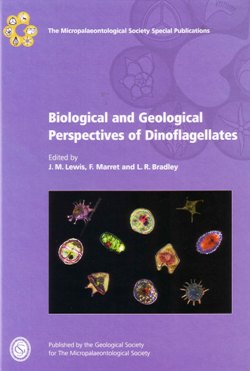
Dinoflagellates are eukaryotic protists and can be found in most aquatic environments, with about half being autotrophs; most significantly, they are a major component of the marine phytoplankton. Specific dinoflagellates are responsible for harmful algal blooms and paralytic shellfish poisoning.
The organic-walled cysts of dinoflagellates (dinocysts) have a fossil record stretching back to the Middle Triassic and quickly radiated reaching peaks in diversity during the Albian, Maastrichtian and early Eocene. However, they have a geochemical signal (dinosterane) suggesting an ancestry at least back to the Early Cambrian.
Dinoflagellate cysts tick all the right boxes when it comes to index fossils: wide geographic distribution, ecologic tolerance, abundance, rapid evolution rate and distinct morphologic features. In 1996 the late Robert Knox opined that ‘They are now established as perhaps the most effective means of correlating across the broad spectrum of facies encountered in the onshore and offshore basins of NW Europe’.
Since the classic incubation experiments by David Wall and Barrie Dale in the 1960s confirmed the relationship between fossil cysts and living thecae, the need for collaboration between biologists and palaeontologists became apparent. So began the first in a series of ‘Fossil and Modern Dinoflagellate’ conferences in 1978. This volume represents the fruits of the ninth such meeting held at the University of Liverpool in 2011.
The volume kicks off with an insightful personal account of the history of the ‘Dino conferences’ by Martin Head and Rex Harland, followed by a short review by E. Potvin, and a citation by Jim Riding for a (richly deserved) Lifetime Achievement Award bestowed on Rob Fensome (and his response).
Rather than present an array of loosely connected conference papers, the editors have sensibly arranged the rest of the volume into four main themes reflecting the structure of the meeting itself: Environmental Change, Ecology & Palaeoecology, Life Cycles & Diversity, and Stratigraphy & Evolution.
Each section begins with a ‘keynote paper’ and ends with a paper devoted to future research. Abstracts to papers and posters not featured in the volume are also helpfully included. Because the Neogene is effectively the interface between fossil and living dinoflagellates, it is no surprise that the bulk of this volume covers post-Paleogene themes. In his response, Rob Fensome expressed concern for the apparent decline in pre-Neogene studies ‘in the context of our understanding of dinoflagellate evolution’.
The editors should be congratulated on producing such a worthy addition to The Micropalaeontological Society’s Special Publication series.
Reviewed by James Powell
BIOLOGICAL AND GEOLOGICAL PERSPECTIVES OF DINOFLAGELLATES by J.M. LEWIS, F. MARRET AND L.R. BRADLEY (eds) . The Micropalaeontological Society, Special Publications, Geological Society, London, 2013. TMS Member Price £50.00